在 R 中估计 GARCH 参数存在的问题(基于 rugarch 包)
在 R 中估计 GARCH 参数存在的问题(基于 rugarch 包)
本文翻译自《Problems in Estimating GARCH Parameters in R (Part 2; rugarch)》
原文链接:https://ntguardian.wordpress.com/2019/01/28/problems-estimating-garch-parameters-r-part-2-rugarch/
导论
这是一篇本应早就写完的博客文章。一年前我写了一篇文章,关于在 R 中估计 GARCH(1, 1) 模型参数时遇到的问题。我记录了参数估计的行为(重点是 \(\beta\)),以及使用 fGarch 计算这些估计值时发现的病态行为。我在 R 社区呼吁帮助,包括通过 R Finance 邮件列表发送我的博客文章。
反馈没有让我感到失望。你可以看到一些邮件列表反馈,并且一些来自 Reddit 的评论也很有帮助,但我认为我得到的最佳反馈来自于我自己的电子邮件。
Dr. Brian G. Peterson 作为 R 金融社区的一员,给我发送了一些发人深思的电子邮件。首先,他告诉我 fGarch 不再是处理 GARCH 模型的首选方案。RMetrics 套件包(包括 fGarch)由 ETH Zürich 的 Diethelm Würtz 教授维护。他在 2016 年的车祸中丧生。
Dr. Peterson 建议我研究另外两个用于 GARCH 建模的现代软件包,rugarch(适用于单变量 GARCH 模型)和 rmgarch(适用于多变量 GARCH 模型)。之前我没有听说过这些包(我之所以知道 fGarch 的原因是因为它在由 Shumway 和 Stoffer 编写的时间序列教科书——Time Series Analysis and Its Applications with R Examples 中),所以我非常感谢这个建议。由于我现在对单变量时间序列感兴趣,所以我研究了 rugarch。该软件包似乎具有比 fGarch 更多的功能和函数,这可以解释为什么它似乎更难以使用。然而,包的 vignette 很有帮助,值得打印出来。
Dr. Peterson 对我提出的应用也有一些有趣的评论。他认为,日内数据应优于日间数据,并且模拟数据(包括模拟 GARCH 过程)具有在实际数据中看不到的特质。获取日间数据的便利性(特别是亚洲金融危机期间的 USD/JPY,这是我正在研究的检验统计量的预期应用)激发了我对日间数据的兴趣。不过,他的评论可能会让我重新考虑这个应用。[1](我也许应该试图通过 EUR/USD 来检测 2010 年欧元区金融危机。为此,我可以从 HistData.com 获得免费的日内数据。)但是,如果对于小样本而言不能信任标准差的估计,我们的检验统计量仍然会遇到麻烦,因为它涉及小样本的参数估计。
他还警告说,模拟数据表现出在实际数据中看不到的行为。这可能是真的,但模拟数据很重要,因为它可以被认为是统计学家的最佳情景。另外,生成模拟数据的过程的属性是先验已知的,包括生成参数的值,以及哪些假设(例如序列中是否存在结构变化)是真的。这允许对估计器和检验进行健全的检查。这对现实世界来说是不可能的,因为我们没有所需的先验知识。
Prof. André Portela Santos 要求我重复模拟,但使用 \(\alpha = 0.6\),因为这些值比我选择的 \(\alpha = \beta = 0.2\) 更常见。这是一个很好的建议,除了 \(\alpha = \beta = 0.2\) 之外,我还会在博文里考虑此范围内的参数。然而,我的模拟暗示当 \(\alpha = \beta = 0.2\) 时,估计算法似乎想要接近较大的 \(\beta\)。我也很惊讶,因为我的导师给我的印象是,\(\alpha\) 或 \(\beta\) 大的 GARCH 过程更难以处理。最后,如果估计量严重有偏,我们可能会看到大多数估计参数位于该范围内,但这并不意味着“正确”值位于该范围内。我的模拟显示 fGarch 很难发现 \(\alpha = \beta = 0.2\),即使这些参数是“真的”。Prof. Santos 的评论让我想要做一个在真实世界中 GARCH 参数的估计是什么样子的元研究(metastudy)。(可能有也可能没有,我没有检查过。如果有人知道,请分享。)
我的导师联系了另一位 GARCH 模型的专家,并获得了一些反馈。据推测,\(\beta\) 的标准差很大,因此参数估计应该有很大的变动范围。即使对于小样本,我的一些模拟也认同这种行为,但同时显示出对 \(\beta = 0\) 和 \(\beta = 1\) 令人不舒服的偏向。正如我假设的那样,这可能是优化程序的结果。
因此,鉴于此反馈,我将进行更多的模拟实验。我不会再研究 fGarch 或 tseries 了,我将专门研究 rugarch。我将探讨包支持的不同优化程序。我不会像我在第一篇文章中那样画图,这些图只是为了表明存在的问题及其严重性。相反,我将考察由不同优化程序生成的估计器的特性。
rugarch 简介
如上所述,rugarch 是一个用于处理 GARCH 模型的软件包,一个主要的用例显然是估计模型的参数。在这里,我将演示如何指定 GARCH 模型、模拟模型的数据以及估计参数。在此之后,我们可以深入了解模拟研究。
library(rugarch)
## Loading required package: parallel
##
## Attaching package: 'rugarch'
## The following object is masked from 'package:stats':
##
## sigma
指定一个 \(\text{GARCH}(1, 1)\) 模型
要使用 GARCH 模型,我们需要指定它。执行此操作的函数是 ugarchspec()。我认为最重要的参数是 variance.model 和 mean.model。
variance.model 是一个命名列表,也许最感兴趣的两个元素是 model 和 garchOrder。model 是一个字符串,指定拟合哪种类型的 GARCH 模型。包支持许多主要的 GARCH 模型(例如 EGARCH、IGARCH 等),对于“普通”GARCH 模型,要将其设置为 sGARCH(或者只是忽略它,标准模型是默认的)。garchOrder 是模型中 ARCH 和 GARCH 部分的阶数向量。
mean.model 允许拟合 ARMA-GARCH 模型,并且像 variance.model 一样接受一个命名列表,最感兴趣的参数是 armaOrder 和 include.mean。armaOrder 就像 garchOrder,它是一个指定 ARMA 模型阶数的向量。include.mean 是一个布尔值,如果为 true,则允许模型的 ARMA 部分具有非零均值。
在模拟过程时,我们需要设置参数的值。这是通过 fixed.pars 参数完成的,该参数接受命名列表,列表的元素是数字。它们需要符合函数对于参数的约定。例如,如果我们想设置 \(\text{GARCH}(1,1)\) 模型的参数,我们列表元素的名称应该是 alpha1 和 beta1。如果计划是模拟一个模型,则应以这种方式设置模型中的每个参数。
还有其他有趣的参数,但我只关注这些,因为默认指定是 ARMA-GARCH 模型,ARMA 阶数为 \((1,1)\),非零均值,并且 GARCH 模型的阶数是 \((1, 1)\)。这不是我想要的普通 \(\text{GARCH}(1,1)\) 模型,所以我几乎总是要修改它。
spec1 <- ugarchspec(
mean.model = list(
armaOrder = c(0,0), include.mean = FALSE),
fixed.pars = list(
"omega" = 0.2, "alpha1" = 0.2, "beta1" = 0.2))
spec2 <- ugarchspec(
mean.model = list(
armaOrder = c(0,0), include.mean = FALSE),
fixed.pars = list(
"omega" = 0.2, "alpha1" = 0.1, "beta1" = 0.7))
show(spec1)
##
## *---------------------------------*
## * GARCH Model Spec *
## *---------------------------------*
##
## Conditional Variance Dynamics
## ------------------------------------
## GARCH Model : sGARCH(1,1)
## Variance Targeting : FALSE
##
## Conditional Mean Dynamics
## ------------------------------------
## Mean Model : ARFIMA(0,0,0)
## Include Mean : FALSE
## GARCH-in-Mean : FALSE
##
## Conditional Distribution
## ------------------------------------
## Distribution : norm
## Includes Skew : FALSE
## Includes Shape : FALSE
## Includes Lambda : FALSE
show(spec2)
##
## *---------------------------------*
## * GARCH Model Spec *
## *---------------------------------*
##
## Conditional Variance Dynamics
## ------------------------------------
## GARCH Model : sGARCH(1,1)
## Variance Targeting : FALSE
##
## Conditional Mean Dynamics
## ------------------------------------
## Mean Model : ARFIMA(0,0,0)
## Include Mean : FALSE
## GARCH-in-Mean : FALSE
##
## Conditional Distribution
## ------------------------------------
## Distribution : norm
## Includes Skew : FALSE
## Includes Shape : FALSE
## Includes Lambda : FALSE
模拟一个 GARCH 过程
函数 ugarchpath() 模拟由 ugarchspec() 指定的 GARCH 模型。该函数首先需要由 ugarchspec() 创建的指定对象。参数 n.sim 和 n.start 分别指定过程的大小和预热期的长度(分别默认为 1000 和 0。我强烈建议将预热期设置为至少 500,但我设置为 1000)。该函数创建的对象不仅包含模拟序列,还包含残差和 \(\sigma_t\)。
rseed 参数控制函数用于生成数据的随机种子。请注意,此函数会有效地忽略 set.seed(),因此如果需要一致的结果,则需要设置此参数。
这些对象相应的 plot() 方法并不完全透明。它可以创建一些图,当在命令行中对 uGARCHpath 对象调用 plot() 时,系统会提示用户输入与所需图形对应的数字。这有时挺痛苦,所以不要忘记将所需的编号传递给 which 参数以避免提示,设置 which = 2 将正好给出序列的图。
old_par <- par()
par(mfrow = c(2, 2))
x_obj <- ugarchpath(
spec1, n.sim = 1000, n.start = 1000, rseed = 111217)
show(x_obj)
##
## *------------------------------------*
## * GARCH Model Path Simulation *
## *------------------------------------*
## Model: sGARCH
## Horizon: 1000
## Simulations: 1
## Seed Sigma2.Mean Sigma2.Min Sigma2.Max Series.Mean
## sim1 111217 0.332 0.251 0.915 0.000165
## Mean(All) 0 0.332 0.251 0.915 0.000165
## Unconditional NA 0.333 NA NA 0.000000
## Series.Min Series.Max
## sim1 -1.76 1.62
## Mean(All) -1.76 1.62
## Unconditional NA NA
for (i in 1:4)
{
plot(x_obj, which = i)
}
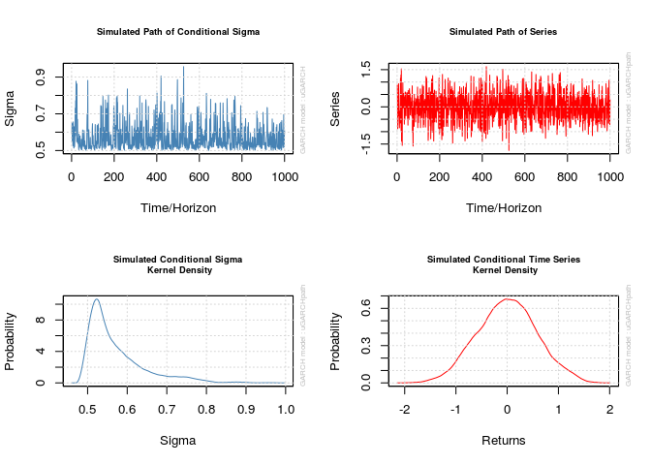
par(old_par)
## Warning in par(old_par): graphical parameter "cin" cannot be set
## Warning in par(old_par): graphical parameter "cra" cannot be set
## Warning in par(old_par): graphical parameter "csi" cannot be set
## Warning in par(old_par): graphical parameter "cxy" cannot be set
## Warning in par(old_par): graphical parameter "din" cannot be set
## Warning in par(old_par): graphical parameter "page" cannot be set
# The actual series
x1 <- x_obj@path$seriesSim
plot.ts(x1)
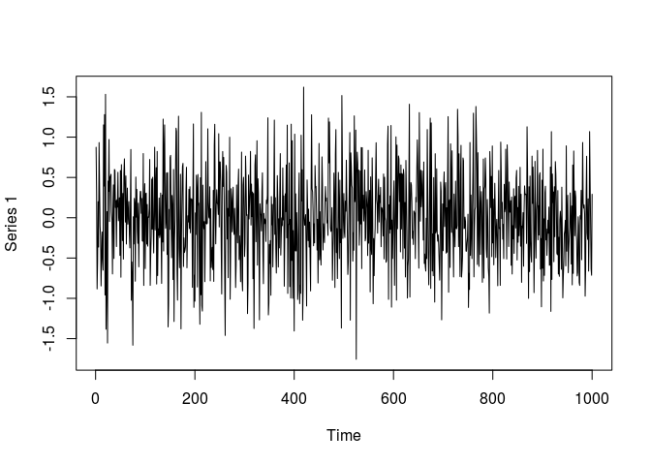
拟合一个 \(\text{GARCH}(1,1)\) 模型
ugarchfit() 函数拟合 GARCH 模型。该函数需要指定和数据集。solver 参数接受一个字符串,说明要使用哪个数值优化器来寻找参数估计值。函数的大多数参数管理数值优化器的接口。特别是,solver.control 可以接受一个传递给优化器的参数列表。我们稍后会更详细地讨论这个问题。
用于生成模拟数据的指定将不适用于 ugarchfit(),因为它包含其参数的固定值。在我的情况下,我将需要创建第二个指定对象。
spec <- ugarchspec(
mean.model = list(armaOrder = c(0, 0), include.mean = FALSE))
fit <- ugarchfit(spec, data = x1)
show(fit)
##
## *---------------------------------*
## * GARCH Model Fit *
## *---------------------------------*
##
## Conditional Variance Dynamics
## -----------------------------------
## GARCH Model : sGARCH(1,1)
## Mean Model : ARFIMA(0,0,0)
## Distribution : norm
##
## Optimal Parameters
## ------------------------------------
## Estimate Std. Error t value Pr(>|t|)
## omega 0.000713 0.001258 0.56696 0.57074
## alpha1 0.002905 0.003714 0.78206 0.43418
## beta1 0.994744 0.000357 2786.08631 0.00000
##
## Robust Standard Errors:
## Estimate Std. Error t value Pr(>|t|)
## omega 0.000713 0.001217 0.58597 0.55789
## alpha1 0.002905 0.003661 0.79330 0.42760
## beta1 0.994744 0.000137 7250.45186 0.00000
##
## LogLikelihood : -860.486
##
## Information Criteria
## ------------------------------------
##
## Akaike 1.7270
## Bayes 1.7417
## Shibata 1.7270
## Hannan-Quinn 1.7326
##
## Weighted Ljung-Box Test on Standardized Residuals
## ------------------------------------
## statistic p-value
## Lag[1] 3.998 0.04555
## Lag[2*(p+q)+(p+q)-1][2] 4.507 0.05511
## Lag[4*(p+q)+(p+q)-1][5] 9.108 0.01555
## d.o.f=0
## H0 : No serial correlation
##
## Weighted Ljung-Box Test on Standardized Squared Residuals
## ------------------------------------
## statistic p-value
## Lag[1] 29.12 6.786e-08
## Lag[2*(p+q)+(p+q)-1][5] 31.03 1.621e-08
## Lag[4*(p+q)+(p+q)-1][9] 32.26 1.044e-07
## d.o.f=2
##
## Weighted ARCH LM Tests
## ------------------------------------
## Statistic Shape Scale P-Value
## ARCH Lag[3] 1.422 0.500 2.000 0.2331
## ARCH Lag[5] 2.407 1.440 1.667 0.3882
## ARCH Lag[7] 2.627 2.315 1.543 0.5865
##
## Nyblom stability test
## ------------------------------------
## Joint Statistic: 0.9518
## Individual Statistics:
## omega 0.3296
## alpha1 0.2880
## beta1 0.3195
##
## Asymptotic Critical Values (10% 5% 1%)
## Joint Statistic: 0.846 1.01 1.35
## Individual Statistic: 0.35 0.47 0.75
##
## Sign Bias Test
## ------------------------------------
## t-value prob sig
## Sign Bias 0.3946 6.933e-01
## Negative Sign Bias 3.2332 1.264e-03 ***
## Positive Sign Bias 4.2142 2.734e-05 ***
## Joint Effect 28.2986 3.144e-06 ***
##
##
## Adjusted Pearson Goodness-of-Fit Test:
## ------------------------------------
## group statistic p-value(g-1)
## 1 20 20.28 0.3779
## 2 30 26.54 0.5965
## 3 40 36.56 0.5817
## 4 50 47.10 0.5505
##
##
## Elapsed time : 2.60606
par(mfrow = c(3, 4))
for (i in 1:12)
{
plot(fit, which = i)
}
##
## please wait...calculating quantiles...
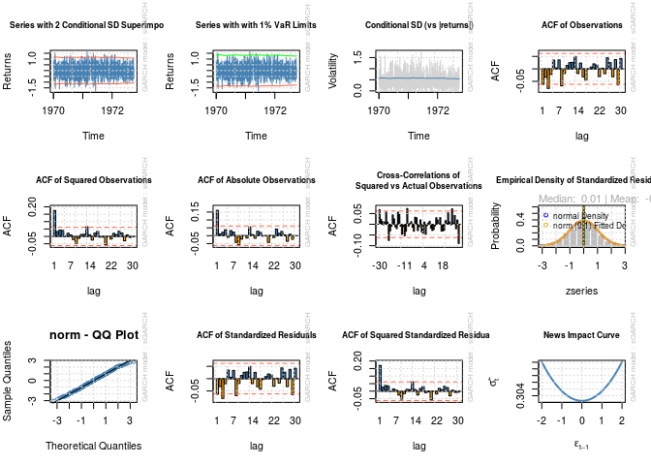
par(old_par)
## Warning in par(old_par): graphical parameter "cin" cannot be set
## Warning in par(old_par): graphical parameter "cra" cannot be set
## Warning in par(old_par): graphical parameter "csi" cannot be set
## Warning in par(old_par): graphical parameter "cxy" cannot be set
## Warning in par(old_par): graphical parameter "din" cannot be set
## Warning in par(old_par): graphical parameter "page" cannot be set
注意估计的参数和标准差?即使对于 1000 的样本大小,估计也与“正确”数字相去甚远,并且基于估计标准差的合理置信区间不包含正确的值。看起来我在上一篇文章中记录的问题并没有消失。
出于好奇,在 Prof. Santos 建议范围的其他指定会发生什么?
x_obj <- ugarchpath(
spec2, n.start = 1000, rseed = 111317)
x2 <- x_obj@path$seriesSim
fit <- ugarchfit(spec, x2)
show(fit)
##
## *---------------------------------*
## * GARCH Model Fit *
## *---------------------------------*
##
## Conditional Variance Dynamics
## -----------------------------------
## GARCH Model : sGARCH(1,1)
## Mean Model : ARFIMA(0,0,0)
## Distribution : norm
##
## Optimal Parameters
## ------------------------------------
## Estimate Std. Error t value Pr(>|t|)
## omega 0.001076 0.002501 0.43025 0.66701
## alpha1 0.001992 0.002948 0.67573 0.49921
## beta1 0.997008 0.000472 2112.23364 0.00000
##
## Robust Standard Errors:
## Estimate Std. Error t value Pr(>|t|)
## omega 0.001076 0.002957 0.36389 0.71594
## alpha1 0.001992 0.003510 0.56767 0.57026
## beta1 0.997008 0.000359 2777.24390 0.00000
##
## LogLikelihood : -1375.951
##
## Information Criteria
## ------------------------------------
##
## Akaike 2.7579
## Bayes 2.7726
## Shibata 2.7579
## Hannan-Quinn 2.7635
##
## Weighted Ljung-Box Test on Standardized Residuals
## ------------------------------------
## statistic p-value
## Lag[1] 0.9901 0.3197
## Lag[2*(p+q)+(p+q)-1][2] 1.0274 0.4894
## Lag[4*(p+q)+(p+q)-1][5] 3.4159 0.3363
## d.o.f=0
## H0 : No serial correlation
##
## Weighted Ljung-Box Test on Standardized Squared Residuals
## ------------------------------------
## statistic p-value
## Lag[1] 3.768 0.05226
## Lag[2*(p+q)+(p+q)-1][5] 4.986 0.15424
## Lag[4*(p+q)+(p+q)-1][9] 7.473 0.16272
## d.o.f=2
##
## Weighted ARCH LM Tests
## ------------------------------------
## Statistic Shape Scale P-Value
## ARCH Lag[3] 0.2232 0.500 2.000 0.6366
## ARCH Lag[5] 0.4793 1.440 1.667 0.8897
## ARCH Lag[7] 2.2303 2.315 1.543 0.6686
##
## Nyblom stability test
## ------------------------------------
## Joint Statistic: 0.3868
## Individual Statistics:
## omega 0.2682
## alpha1 0.2683
## beta1 0.2669
##
## Asymptotic Critical Values (10% 5% 1%)
## Joint Statistic: 0.846 1.01 1.35
## Individual Statistic: 0.35 0.47 0.75
##
## Sign Bias Test
## ------------------------------------
## t-value prob sig
## Sign Bias 0.5793 0.5625
## Negative Sign Bias 1.3358 0.1819
## Positive Sign Bias 1.5552 0.1202
## Joint Effect 5.3837 0.1458
##
##
## Adjusted Pearson Goodness-of-Fit Test:
## ------------------------------------
## group statistic p-value(g-1)
## 1 20 24.24 0.1871
## 2 30 30.50 0.3894
## 3 40 38.88 0.4753
## 4 50 48.40 0.4974
##
##
## Elapsed time : 2.841597
没有更好。现在让我们看看当我们使用不同的优化算法时会发生什么。
rugarch 中的优化与参数估计
优化器的选择
ugarchfit() 的默认参数很好地找到了我称之为模型 2 的适当参数(其中 \(\alpha = 0.1\) 和 \(\beta = 0.7\)),但不适用于模型 1(\(\alpha = \beta = 0.2\))。我想知道的是何时一个求解器能击败另一个求解器。
正如 Vivek Rao[2] 在 R-SIG-Finance 邮件列表中所说,“最佳”估计是最大化似然函数(或等效地,对数似然函数)的估计,在上一篇文章中我忽略了检查对数似然函数值。在这里,我将看到哪些优化程序导致最大对数似然。
下面是一个辅助函数,它简化了拟合 GARCH 模型参数、提取对数似然、参数值和标准差的过程,同时允许将不同的值传递给 solver 和 solver.control。
evalSolverFit <- function(spec, data,
solver = "solnp",
solver.control = list())
{
# Calls ugarchfit(spec, data, solver, solver.control), and returns a vector
# containing the log likelihood, parameters, and parameter standard errors.
# Parameters are equivalent to those seen in ugarchfit(). If the solver fails
# to converge, NA will be returned
vec <- NA
tryCatch(
{
fit <- ugarchfit(
spec = spec,
data = data,
solver = solver,
solver.control = solver.control)
coef_se_names <- paste(
"se", names(fit@fit$coef), sep = ".")
se <- fit@fit$se.coef
names(se) <- coef_se_names
robust_coef_se_names <- paste(
"robust.se", names(fit@fit$coef), sep = ".")
robust.se <- fit@fit$robust.se.coef
names(robust.se) <- robust_coef_se_names
vec <- c(fit@fit$coef, se, robust.se)
vec["LLH"] <- fit@fit$LLH
},
error = function(w) { NA })
return(vec)
}
下面我列出将要考虑的所有优化方案。我只使用 solver.control,但可能有其他参数可以帮助数值优化算法,即 numderiv.control,它们作为控制参数传递给负责标准差计算的数值算法。这利用了包含 numDeriv 的包,它执行数值微分。
solvers <- list(
# A list of lists where each sublist contains parameters to
# pass to a solver
list("solver" = "nlminb", "solver.control" = list()),
list("solver" = "solnp", "solver.control" = list()),
list("solver" = "lbfgs", "solver.control" = list()),
list("solver" = "gosolnp",
"solver.control" = list("n.restarts" = 100, "n.sim" = 100)),
list("solver" = "hybrid", "solver.control" = list()),
list("solver" = "nloptr", "solver.control" = list("solver" = 1)), # COBYLA
list("solver" = "nloptr", "solver.control" = list("solver" = 2)), # BOBYQA
list("solver" = "nloptr", "solver.control" = list("solver" = 3)), # PRAXIS
list("solver" = "nloptr",
"solver.control" = list("solver" = 4)), # NELDERMEAD
list("solver" = "nloptr", "solver.control" = list("solver" = 5)), # SBPLX
list("solver" = "nloptr",
"solver.control" = list("solver" = 6)), # AUGLAG+COBYLA
list("solver" = "nloptr",
"solver.control" = list("solver" = 7)), # AUGLAG+BOBYQA
list("solver" = "nloptr",
"solver.control" = list("solver" = 8)), # AUGLAG+PRAXIS
list("solver" = "nloptr",
"solver.control" = list("solver" = 9)), # AUGLAG+NELDERMEAD
list("solver" = "nloptr",
"solver.control" = list("solver" = 10)) # AUGLAG+SBPLX
)
tags <- c(
# Names for the above list
"nlminb",
"solnp",
"lbfgs",
"gosolnp",
"hybrid",
"nloptr+COBYLA",
"nloptr+BOBYQA",
"nloptr+PRAXIS",
"nloptr+NELDERMEAD",
"nloptr+SBPLX",
"nloptr+AUGLAG+COBYLA",
"nloptr+AUGLAG+BOBYQA",
"nloptr+AUGLAG+PRAXIS",
"nloptr+AUGLAG+NELDERMEAD",
"nloptr+AUGLAG+SBPLX"
)
names(solvers) <- tags
现在让我们进行优化计算选择的交叉射击(gauntlet),看看哪个算法产生的估计在模型 1 生成的数据上达到最大的对数似然。遗憾的是,lbfgs 方法(Broyden-Fletcher-Goldfarb-Shanno 方法的低存储版本)在这个序列上没有收敛,所以我省略了它。
optMethodCompare <- function(data,
spec,
solvers)
{
# Runs all solvers in a list for a dataset
#
# Args:
# data: An object to pass to ugarchfit's data parameter containing the data
# to fit
# spec: A specification created by ugarchspec to pass to ugarchfit
# solvers: A list of lists containing strings of solvers and a list for
# solver.control
#
# Return:
# A matrix containing the result of the solvers (including parameters, se's,
# and LLH)
model_solutions <- lapply(
solvers,
function(s)
{
args <- s
args[["spec"]] <- spec
args[["data"]] <- data
res <- do.call(evalSolverFit, args = args)
return(res)
})
model_solutions <- do.call(
rbind, model_solutions)
return(model_solutions)
}
round(
optMethodCompare(
x1, spec, solvers[c(1:2, 4:15)]), digits = 4)
## omega alpha1 beta1 se.omega se.alpha1 se.beta1 robust.se.omega robust.se.alpha1 robust.se.beta1 LLH
## ------------------------- ------- ------- ------- --------- ---------- --------- ---------------- ----------------- ---------------- ----------
## nlminb 0.2689 0.1774 0.0000 0.0787 0.0472 0.2447 0.0890 0.0352 0.2830 -849.6927
## solnp 0.0007 0.0029 0.9947 0.0013 0.0037 0.0004 0.0012 0.0037 0.0001 -860.4860
## gosolnp 0.2689 0.1774 0.0000 0.0787 0.0472 0.2446 0.0890 0.0352 0.2828 -849.6927
## hybrid 0.0007 0.0029 0.9947 0.0013 0.0037 0.0004 0.0012 0.0037 0.0001 -860.4860
## nloptr+COBYLA 0.0006 0.0899 0.9101 0.0039 0.0306 0.0370 0.0052 0.0527 0.0677 -871.5006
## nloptr+BOBYQA 0.0003 0.0907 0.9093 0.0040 0.0298 0.0375 0.0057 0.0532 0.0718 -872.3436
## nloptr+PRAXIS 0.2689 0.1774 0.0000 0.0786 0.0472 0.2444 0.0888 0.0352 0.2823 -849.6927
## nloptr+NELDERMEAD 0.0010 0.0033 0.9935 0.0013 0.0039 0.0004 0.0013 0.0038 0.0001 -860.4845
## nloptr+SBPLX 0.0010 0.1000 0.9000 0.0042 0.0324 0.0386 0.0055 0.0536 0.0680 -872.2736
## nloptr+AUGLAG+COBYLA 0.0006 0.0899 0.9101 0.0039 0.0306 0.0370 0.0052 0.0527 0.0677 -871.5006
## nloptr+AUGLAG+BOBYQA 0.0003 0.0907 0.9093 0.0040 0.0298 0.0375 0.0057 0.0532 0.0718 -872.3412
## nloptr+AUGLAG+PRAXIS 0.1246 0.1232 0.4948 0.0620 0.0475 0.2225 0.0701 0.0439 0.2508 -851.0547
## nloptr+AUGLAG+NELDERMEAD 0.2689 0.1774 0.0000 0.0786 0.0472 0.2445 0.0889 0.0352 0.2826 -849.6927
## nloptr+AUGLAG+SBPLX 0.0010 0.1000 0.9000 0.0042 0.0324 0.0386 0.0055 0.0536 0.0680 -872.2736
根据最大似然准则,“最优”结果是由 gosolnp 实现的。结果有一个不幸的属性——\(\beta \approx 0\),这当然不是正确的,但至少 \(\beta\) 的标准差会创建一个包含 \(\beta\) 真值的置信区间。其中,我的首选估计是由 AUGLAG + PRAXIS 生成的,因为 \(\beta\) 似乎是合理的,事实上估计都接近事实(至少在置信区间包含真值的意义上),但不幸的是,即使它们是最合理的,估计并没有最大化对数似然。
如果我们看一下模型 2,我们会看到什么?同样,lbfgs 没有收敛,所以我省略忽略了它。不幸的是,nlminb 也没有收敛,因此也必须省略。
round(
optMethodCompare(
x2, spec, solvers[c(2, 4:15)]), digits = 4)
## omega alpha1 beta1 se.omega se.alpha1 se.beta1 robust.se.omega robust.se.alpha1 robust.se.beta1 LLH
## ------------------------- ------- ------- ------- --------- ---------- --------- ---------------- ----------------- ---------------- ----------
## solnp 0.0011 0.0020 0.9970 0.0025 0.0029 0.0005 0.0030 0.0035 0.0004 -1375.951
## gosolnp 0.0011 0.0020 0.9970 0.0025 0.0029 0.0005 0.0030 0.0035 0.0004 -1375.951
## hybrid 0.0011 0.0020 0.9970 0.0025 0.0029 0.0005 0.0030 0.0035 0.0004 -1375.951
## nloptr+COBYLA 0.0016 0.0888 0.9112 0.0175 0.0619 0.0790 0.0540 0.2167 0.2834 -1394.529
## nloptr+BOBYQA 0.0010 0.0892 0.9108 0.0194 0.0659 0.0874 0.0710 0.2631 0.3572 -1395.310
## nloptr+PRAXIS 0.5018 0.0739 0.3803 0.3178 0.0401 0.3637 0.2777 0.0341 0.3225 -1373.632
## nloptr+NELDERMEAD 0.0028 0.0026 0.9944 0.0028 0.0031 0.0004 0.0031 0.0035 0.0001 -1375.976
## nloptr+SBPLX 0.0029 0.1000 0.9000 0.0146 0.0475 0.0577 0.0275 0.1108 0.1408 -1395.807
## nloptr+AUGLAG+COBYLA 0.0016 0.0888 0.9112 0.0175 0.0619 0.0790 0.0540 0.2167 0.2834 -1394.529
## nloptr+AUGLAG+BOBYQA 0.0010 0.0892 0.9108 0.0194 0.0659 0.0874 0.0710 0.2631 0.3572 -1395.310
## nloptr+AUGLAG+PRAXIS 0.5018 0.0739 0.3803 0.3178 0.0401 0.3637 0.2777 0.0341 0.3225 -1373.632
## nloptr+AUGLAG+NELDERMEAD 0.0001 0.0000 1.0000 0.0003 0.0003 0.0000 0.0004 0.0004 0.0000 -1375.885
## nloptr+AUGLAG+SBPLX 0.0029 0.1000 0.9000 0.0146 0.0475 0.0577 0.0275 0.1108 0.1408 -1395.807
这里是 PRAXIS 和 AUGLAG + PRAXIS 给出了“最优”结果,只有这两种方法做到了。其他优化器给出了明显糟糕的结果。也就是说,“最优”解在参数为非零、置信区间包含正确值上是首选的。
如果我们将样本限制为 100,会发生什么?(lbfgs 仍然不起作用。)
round(
optMethodCompare(
x1[1:100], spec, solvers[c(1:2, 4:15)]), digits = 4)
## omega alpha1 beta1 se.omega se.alpha1 se.beta1 robust.se.omega robust.se.alpha1 robust.se.beta1 LLH
## ------------------------- ------- ------- ------- --------- ---------- --------- ---------------- ----------------- ---------------- ---------
## nlminb 0.0451 0.2742 0.5921 0.0280 0.1229 0.1296 0.0191 0.0905 0.0667 -80.6587
## solnp 0.0451 0.2742 0.5921 0.0280 0.1229 0.1296 0.0191 0.0905 0.0667 -80.6587
## gosolnp 0.0451 0.2742 0.5921 0.0280 0.1229 0.1296 0.0191 0.0905 0.0667 -80.6587
## hybrid 0.0451 0.2742 0.5921 0.0280 0.1229 0.1296 0.0191 0.0905 0.0667 -80.6587
## nloptr+COBYLA 0.0007 0.1202 0.8798 0.0085 0.0999 0.0983 0.0081 0.1875 0.1778 -85.3121
## nloptr+BOBYQA 0.0005 0.1190 0.8810 0.0085 0.0994 0.0992 0.0084 0.1892 0.1831 -85.3717
## nloptr+PRAXIS 0.0451 0.2742 0.5921 0.0280 0.1229 0.1296 0.0191 0.0905 0.0667 -80.6587
## nloptr+NELDERMEAD 0.0451 0.2742 0.5920 0.0281 0.1230 0.1297 0.0191 0.0906 0.0667 -80.6587
## nloptr+SBPLX 0.0433 0.2740 0.5998 0.0269 0.1237 0.1268 0.0182 0.0916 0.0648 -80.6616
## nloptr+AUGLAG+COBYLA 0.0007 0.1202 0.8798 0.0085 0.0999 0.0983 0.0081 0.1875 0.1778 -85.3121
## nloptr+AUGLAG+BOBYQA 0.0005 0.1190 0.8810 0.0085 0.0994 0.0992 0.0084 0.1892 0.1831 -85.3717
## nloptr+AUGLAG+PRAXIS 0.0451 0.2742 0.5921 0.0280 0.1229 0.1296 0.0191 0.0905 0.0667 -80.6587
## nloptr+AUGLAG+NELDERMEAD 0.0451 0.2742 0.5921 0.0280 0.1229 0.1296 0.0191 0.0905 0.0667 -80.6587
## nloptr+AUGLAG+SBPLX 0.0450 0.2742 0.5924 0.0280 0.1230 0.1295 0.0191 0.0906 0.0666 -80.6587
round(
optMethodCompare(
x2[1:100], spec, solvers[c(1:2, 4:15)]), digits = 4)
## omega alpha1 beta1 se.omega se.alpha1 se.beta1 robust.se.omega robust.se.alpha1 robust.se.beta1 LLH
## ------------------------- ------- ------- ------- --------- ---------- --------- ---------------- ----------------- ---------------- ----------
## nlminb 0.7592 0.0850 0.0000 2.1366 0.4813 3.0945 7.5439 1.7763 11.0570 -132.4614
## solnp 0.0008 0.0000 0.9990 0.0291 0.0417 0.0066 0.0232 0.0328 0.0034 -132.9182
## gosolnp 0.0537 0.0000 0.9369 0.0521 0.0087 0.0713 0.0430 0.0012 0.0529 -132.9124
## hybrid 0.0008 0.0000 0.9990 0.0291 0.0417 0.0066 0.0232 0.0328 0.0034 -132.9182
## nloptr+COBYLA 0.0014 0.0899 0.9101 0.0259 0.0330 0.1192 0.0709 0.0943 0.1344 -135.7495
## nloptr+BOBYQA 0.0008 0.0905 0.9095 0.0220 0.0051 0.1145 0.0687 0.0907 0.1261 -135.8228
## nloptr+PRAXIS 0.0602 0.0000 0.9293 0.0522 0.0088 0.0773 0.0462 0.0015 0.0565 -132.9125
## nloptr+NELDERMEAD 0.0024 0.0000 0.9971 0.0473 0.0629 0.0116 0.0499 0.0680 0.0066 -132.9186
## nloptr+SBPLX 0.0027 0.1000 0.9000 0.0238 0.0493 0.1308 0.0769 0.1049 0.1535 -135.9175
## nloptr+AUGLAG+COBYLA 0.0014 0.0899 0.9101 0.0259 0.0330 0.1192 0.0709 0.0943 0.1344 -135.7495
## nloptr+AUGLAG+BOBYQA 0.0008 0.0905 0.9095 0.0221 0.0053 0.1145 0.0687 0.0907 0.1262 -135.8226
## nloptr+AUGLAG+PRAXIS 0.0602 0.0000 0.9294 0.0523 0.0090 0.0771 0.0462 0.0014 0.0565 -132.9125
## nloptr+AUGLAG+NELDERMEAD 0.0000 0.0000 0.9999 0.0027 0.0006 0.0005 0.0013 0.0004 0.0003 -132.9180
## nloptr+AUGLAG+SBPLX 0.0027 0.1000 0.9000 0.0238 0.0493 0.1308 0.0769 0.1049 0.1535 -135.9175
结果并不令人兴奋。多个求解器获得了模型 1 生成序列的“最佳”结果,同时 \(\omega\) 的 95% 置信区间(CI)不包含 \(\omega\) 的真实值,尽管其他的 CI 将包含其真实值。对于由模型 2 生成的序列,最佳结果是由 nlminb 求解器实现的,但参数值不合理,标准差很大。至少 CI 将包含正确值。
从这里开始,我们不应再仅仅关注两个序列,而是在两个模型生成的许多模拟序列中研究这些方法的表现。这篇文章中的模拟对于我的笔记本电脑而言计算量太大,因此我将使用我院系的超级计算机来执行它们,利用其多核进行并行计算。
library(foreach)
library(doParallel)
logfile <- ""
# logfile <- "outfile.log"
# if (!file.exists(logfile)) {
# file.create(logfile)
# }
cl <- makeCluster(
detectCores() - 1, outfile = logfile)
registerDoParallel(cl)
optMethodSims <- function(
gen_spec,
n.sim = 1000,
m.sim = 1000,
fit_spec = ugarchspec(
mean.model = list(
armaOrder = c(0,0), include.mean = FALSE)),
solvers = list(
"solnp" = list(
"solver" = "solnp", "solver.control" = list())),
rseed = NA, verbose = FALSE)
{
# Performs simulations in parallel of GARCH processes via rugarch and returns
# a list with the results of different optimization routines
#
# Args:
# gen_spec: The specification for generating a GARCH sequence, produced by
# ugarchspec
# n.sim: An integer denoting the length of the simulated series
# m.sim: An integer for the number of simulated sequences to generate
# fit_spec: A ugarchspec specification for the model to fit
# solvers: A list of lists containing strings of solvers and a list for
# solver.control
# rseed: Optional seeding value(s) for the random number generator. For
# m.sim>1, it is possible to provide either a single seed to
# initialize all values, or one seed per separate simulation (i.e.
# m.sim seeds). However, in the latter case this may result in some
# slight overhead depending on how large m.sim is
# verbose: Boolean for whether to write data tracking the progress of the
# loop into an output file
# outfile: A string for the file to store verbose output to (relevant only
# if verbose is TRUE)
#
# Return:
# A list containing the result of calling optMethodCompare on each generated
# sequence
fits <- foreach(
i = 1:m.sim,
.packages = c("rugarch"),
.export = c(
"optMethodCompare", "evalSolverFit")) %dopar%
{
if (is.na(rseed))
{
newseed <- NA
}
else if (is.vector(rseed))
{
newseed <- rseed[i]
}
else
{
newseed <- rseed + i - 1
}
if (verbose)
{
cat(as.character(Sys.time()), ": Now on simulation ", i, "\n")
}
sim <- ugarchpath(
gen_spec, n.sim = n.sim, n.start = 1000,
m.sim = 1, rseed = newseed)
x <- sim@path$seriesSim
optMethodCompare(
x, spec = fit_spec, solvers = solvers)
}
return(fits)
}
# Specification 1 first
spec1_n100 <- optMethodSims(
spec1, n.sim = 100, m.sim = 1000,
solvers = solvers, verbose = TRUE)
spec1_n500 <- optMethodSims(
spec1, n.sim = 500, m.sim = 1000,
solvers = solvers, verbose = TRUE)
spec1_n1000 <- optMethodSims(
spec1, n.sim = 1000, m.sim = 1000,
solvers = solvers, verbose = TRUE)
# Specification 2 next
spec2_n100 <- optMethodSims(
spec2, n.sim = 100, m.sim = 1000,
solvers = solvers, verbose = TRUE)
spec2_n500 <- optMethodSims(
spec2, n.sim = 500, m.sim = 1000,
solvers = solvers, verbose = TRUE)
spec2_n1000 <- optMethodSims(
spec2, n.sim = 1000, m.sim = 1000,
solvers = solvers, verbose = TRUE)
以下是一组辅助函数,用于我要进行的分析。
optMethodSims_getAllVals <- function(param,
solver,
reslist)
{
# Get all values for a parameter obtained by a certain solver after getting a
# list of results via optMethodSims
#
# Args:
# param: A string for the parameter to get (such as "beta1")
# solver: A string for the solver for which to get the parameter (such as
# "nlminb")
# reslist: A list created by optMethodSims
#
# Return:
# A vector of values of the parameter for each simulation
res <- sapply(
reslist,
function(l)
{
return(l[solver, param])
})
return(res)
}
optMethodSims_getBestVals <- function(reslist,
opt_vec = TRUE,
reslike = FALSE)
{
# A function that gets the optimizer that maximized the likelihood function
# for each entry in reslist
#
# Args:
# reslist: A list created by optMethodSims
# opt_vec: A boolean indicating whether to return a vector with the name of
# the optimizers that maximized the log likelihood
# reslike: A bookean indicating whether the resulting list should consist of
# matrices of only one row labeled "best" with a structure like
# reslist
#
# Return:
# If opt_vec is TRUE, a list of lists, where each sublist contains a vector
# of strings naming the opimizers that maximized the likelihood function and
# a matrix of the parameters found. Otherwise, just the matrix (resembles
# the list generated by optMethodSims)
res <- lapply(
reslist,
function(l)
{
max_llh <- max(l[, "LLH"], na.rm = TRUE)
best_idx <- (l[, "LLH"] == max_llh) & (!is.na(l[, "LLH"]))
best_mat <- l[best_idx, , drop = FALSE]
if (opt_vec)
{
return(
list(
"solvers" = rownames(best_mat), "params" = best_mat))
}
else
{
return(best_mat)
}
})
if (reslike)
{
res <- lapply(
res,
function(l)
{
mat <- l$params[1, , drop = FALSE]
rownames(mat) <- "best"
return(mat)
})
}
return(res)
}
optMethodSims_getCaptureRate <- function(param,
solver,
reslist,
multiplier = 2,
spec,
use_robust = TRUE)
{
# Gets the rate a confidence interval for a parameter captures the true value
#
# Args:
# param: A string for the parameter being worked with
# solver: A string for the solver used to estimate the parameter
# reslist: A list created by optMethodSims
# multiplier: A floating-point number for the multiplier to the standard
# error, appropriate for the desired confidence level
# spec: A ugarchspec specification with the fixed parameters containing the
# true parameter value
# use_robust: Use robust standard errors for computing CIs
#
# Return:
# A float for the proportion of times the confidence interval captured the
# true parameter value
se_string <- ifelse(
use_robust, "robust.se.", "se.")
est <- optMethodSims_getAllVals(
param, solver, reslist)
moe_est <- multiplier * optMethodSims_getAllVals(
paste0(se_string, param), solver, reslist)
param_val <- spec@model$fixed.pars[[param]]
contained <- (param_val <= est + moe_est) & (param_val >= est - moe_est)
return(mean(contained, na.rm = TRUE))
}
optMethodSims_getMaxRate <- function(solver,
maxlist)
{
# Gets how frequently a solver found a maximal log likelihood
#
# Args:
# solver: A string for the solver
# maxlist A list created by optMethodSims_getBestVals with entries
# containing vectors naming the solvers that maximized the log
# likelihood
#
# Return:
# The proportion of times the solver maximized the log likelihood
maxed <- sapply(
maxlist,
function(l)
{
solver %in% l$solvers
})
return(mean(maxed))
}
optMethodSims_getFailureRate <- function(solver,
reslist)
{
# Computes the proportion of times a solver failed to converge.
#
# Args:
# solver: A string for the solver
# reslist: A list created by optMethodSims
#
# Return:
# Numeric proportion of times a solver failed to converge
failed <- sapply(
reslist,
function(l)
{
is.na(l[solver, "LLH"])
})
return(mean(failed))
}
# Vectorization
optMethodSims_getCaptureRate <- Vectorize(
optMethodSims_getCaptureRate, vectorize.args = "solver")
optMethodSims_getMaxRate <- Vectorize(
optMethodSims_getMaxRate, vectorize.args = "solver")
optMethodSims_getFailureRate <- Vectorize(
optMethodSims_getFailureRate, vectorize.args = "solver")
我首先为固定样本量和模型创建表:
- 所有求解器中,某个求解器达到最高对数似然的频率
- 某个求解器未能收敛的频率
- 基于某个求解器的解,95% 置信区间包含每个参数真实值的频率(称为“捕获率”,并使用稳健标准差)
solver_table <- function(reslist,
tags,
spec)
{
# Creates a table describing important solver statistics
#
# Args:
# reslist: A list created by optMethodSims
# tags: A vector with strings naming all solvers to include in the table
# spec: A ugarchspec specification with the fixed parameters containing the
# true parameter value
#
# Return:
# A matrix containing metrics describing the performance of the solvers
params <- names(spec1@model$fixed.pars)
max_rate <- optMethodSims_getMaxRate(
tags, optMethodSims_getBestVals(reslist))
failure_rate <- optMethodSims_getFailureRate(
tags, reslist)
capture_rate <- lapply(
params,
function(p)
{
optMethodSims_getCaptureRate(
p, tags, reslist, spec = spec)
})
return_mat <- cbind(
"Maximization Rate" = max_rate,
"Failure Rate" = failure_rate)
capture_mat <- do.call(cbind, capture_rate)
colnames(capture_mat) <- paste(
params, "95% CI Capture Rate")
return_mat <- cbind(
return_mat, capture_mat)
return(return_mat)
}
- Model 1, \(n=100\)
as.data.frame(
round(
solver_table(spec1_n100, tags, spec1) * 100,
digits = 1))
## Maximization Rate Failure Rate omega 95% CI Capture Rate alpha1 95% CI Capture Rate beta1 95% CI Capture Rate
## ------------------------- ------------------ ------------- -------------------------- --------------------------- --------------------------
## nlminb 16.2 20.0 21.8 29.2 24.0
## solnp 0.1 0.0 13.7 24.0 15.4
## lbfgs 15.1 35.2 56.6 67.9 58.0
## gosolnp 20.3 0.0 20.3 32.6 21.9
## hybrid 0.1 0.0 13.7 24.0 15.4
## nloptr+COBYLA 0.0 0.0 6.3 82.6 19.8
## nloptr+BOBYQA 0.0 0.0 5.4 82.1 18.5
## nloptr+PRAXIS 15.8 0.0 42.1 54.5 44.1
## nloptr+NELDERMEAD 0.4 0.0 5.7 19.3 8.1
## nloptr+SBPLX 0.1 0.0 7.7 85.7 24.1
## nloptr+AUGLAG+COBYLA 0.0 0.0 6.1 84.5 19.9
## nloptr+AUGLAG+BOBYQA 0.1 0.0 6.5 83.2 19.4
## nloptr+AUGLAG+PRAXIS 22.6 0.0 41.2 54.6 44.1
## nloptr+AUGLAG+NELDERMEAD 11.1 0.0 7.5 18.8 9.7
## nloptr+AUGLAG+SBPLX 0.6 0.0 7.9 86.5 23.0
- Model 1, \(n=500\)
as.data.frame(
round(
solver_table(spec1_n500, tags, spec1) * 100,
digits = 1))
## Maximization Rate Failure Rate omega 95% CI Capture Rate alpha1 95% CI Capture Rate beta1 95% CI Capture Rate
## ------------------------- ------------------ ------------- -------------------------- --------------------------- --------------------------
## nlminb 21.2 0.4 63.3 67.2 63.8
## solnp 0.1 0.2 32.2 35.6 32.7
## lbfgs 4.5 41.3 85.0 87.6 85.7
## gosolnp 35.1 0.0 69.0 73.2 69.5
## hybrid 0.1 0.0 32.3 35.7 32.8
## nloptr+COBYLA 0.0 0.0 3.2 83.3 17.8
## nloptr+BOBYQA 0.0 0.0 3.5 81.5 18.1
## nloptr+PRAXIS 18.0 0.0 83.9 87.0 84.2
## nloptr+NELDERMEAD 0.0 0.0 16.4 20.7 16.7
## nloptr+SBPLX 0.1 0.0 3.7 91.4 15.7
## nloptr+AUGLAG+COBYLA 0.0 0.0 3.2 83.3 17.8
## nloptr+AUGLAG+BOBYQA 0.0 0.0 3.5 81.5 18.1
## nloptr+AUGLAG+PRAXIS 21.9 0.0 80.2 87.4 83.4
## nloptr+AUGLAG+NELDERMEAD 0.6 0.0 20.0 24.0 20.5
## nloptr+AUGLAG+SBPLX 0.0 0.0 3.7 91.4 15.7
- Model 1, \(n=1000\)
as.data.frame(
round(
solver_table(spec1_n1000, tags, spec1) * 100,
digits = 1))
## Maximization Rate Failure Rate omega 95% CI Capture Rate alpha1 95% CI Capture Rate beta1 95% CI Capture Rate
## ------------------------- ------------------ ------------- -------------------------- --------------------------- --------------------------
## nlminb 21.5 0.1 88.2 86.1 87.8
## solnp 0.4 0.2 54.9 53.6 54.6
## lbfgs 1.1 44.8 91.5 88.0 91.8
## gosolnp 46.8 0.0 87.2 85.1 87.0
## hybrid 0.5 0.0 55.0 53.6 54.7
## nloptr+COBYLA 0.0 0.0 4.1 74.5 15.0
## nloptr+BOBYQA 0.0 0.0 3.6 74.3 15.9
## nloptr+PRAXIS 17.7 0.0 92.6 90.2 92.2
## nloptr+NELDERMEAD 0.0 0.0 30.5 29.6 30.9
## nloptr+SBPLX 0.0 0.0 3.0 82.3 11.6
## nloptr+AUGLAG+COBYLA 0.0 0.0 4.1 74.5 15.0
## nloptr+AUGLAG+BOBYQA 0.0 0.0 3.6 74.3 15.9
## nloptr+AUGLAG+PRAXIS 13.0 0.0 83.4 93.9 86.7
## nloptr+AUGLAG+NELDERMEAD 0.0 0.0 34.6 33.8 35.0
## nloptr+AUGLAG+SBPLX 0.0 0.0 3.0 82.3 11.6
- Model 2, \(n=100\)
as.data.frame(
round(
solver_table(spec2_n100, tags, spec2) * 100,
digits = 1))
## Maximization Rate Failure Rate omega 95% CI Capture Rate alpha1 95% CI Capture Rate beta1 95% CI Capture Rate
## ------------------------- ------------------ ------------- -------------------------- --------------------------- --------------------------
## nlminb 8.2 24.2 22.3 34.7 23.9
## solnp 0.3 0.0 21.1 32.6 21.3
## lbfgs 11.6 29.5 74.9 73.2 70.4
## gosolnp 19.0 0.0 31.9 41.2 30.8
## hybrid 0.3 0.0 21.1 32.6 21.3
## nloptr+COBYLA 0.0 0.0 20.5 94.7 61.7
## nloptr+BOBYQA 0.2 0.0 19.3 95.8 62.2
## nloptr+PRAXIS 16.0 0.0 70.2 57.2 52.8
## nloptr+NELDERMEAD 0.2 0.0 7.8 27.8 14.1
## nloptr+SBPLX 0.1 0.0 24.9 91.0 65.0
## nloptr+AUGLAG+COBYLA 0.0 0.0 21.2 95.1 62.5
## nloptr+AUGLAG+BOBYQA 0.9 0.0 20.1 96.2 62.5
## nloptr+AUGLAG+PRAXIS 38.8 0.0 70.4 57.2 52.7
## nloptr+AUGLAG+NELDERMEAD 14.4 0.0 10.7 26.0 16.1
## nloptr+AUGLAG+SBPLX 0.1 0.0 25.8 91.9 65.5
- Model 2, \(n=500\)
as.data.frame(
round(
solver_table(spec2_n500, tags, spec2) * 100,
digits = 1))
## Maximization Rate Failure Rate omega 95% CI Capture Rate alpha1 95% CI Capture Rate beta1 95% CI Capture Rate
## ------------------------- ------------------ ------------- -------------------------- --------------------------- --------------------------
## nlminb 1.7 1.6 35.0 37.2 34.2
## solnp 0.1 0.2 46.2 48.6 45.3
## lbfgs 2.2 38.4 85.2 88.1 82.3
## gosolnp 5.2 0.0 74.9 77.8 72.7
## hybrid 0.1 0.0 46.1 48.5 45.2
## nloptr+COBYLA 0.0 0.0 8.2 100.0 40.5
## nloptr+BOBYQA 0.0 0.0 9.5 100.0 41.0
## nloptr+PRAXIS 17.0 0.0 83.8 85.1 81.0
## nloptr+NELDERMEAD 0.0 0.0 26.9 38.2 27.0
## nloptr+SBPLX 0.0 0.0 8.2 100.0 40.2
## nloptr+AUGLAG+COBYLA 0.0 0.0 8.2 100.0 40.5
## nloptr+AUGLAG+BOBYQA 0.0 0.0 9.5 100.0 41.0
## nloptr+AUGLAG+PRAXIS 77.8 0.0 84.4 85.4 81.3
## nloptr+AUGLAG+NELDERMEAD 1.1 0.0 32.5 40.3 32.3
## nloptr+AUGLAG+SBPLX 0.0 0.0 8.2 100.0 40.2
- Model 2, \(n=1000\)
as.data.frame(
round(
solver_table(spec2_n1000, tags, spec2) * 100,
digits = 1))
## Maximization Rate Failure Rate omega 95% CI Capture Rate alpha1 95% CI Capture Rate beta1 95% CI Capture Rate
## ------------------------- ------------------ ------------- -------------------------- --------------------------- --------------------------
## nlminb 2.7 0.7 64.1 68.0 63.8
## solnp 0.0 0.0 70.1 73.8 69.8
## lbfgs 0.0 43.4 90.6 91.5 89.9
## gosolnp 3.2 0.0 87.5 90.3 86.9
## hybrid 0.0 0.0 70.1 73.8 69.8
## nloptr+COBYLA 0.0 0.0 2.3 100.0 20.6
## nloptr+BOBYQA 0.0 0.0 2.5 100.0 22.6
## nloptr+PRAXIS 14.1 0.0 89.1 91.3 88.5
## nloptr+NELDERMEAD 0.0 0.0 46.3 55.6 45.4
## nloptr+SBPLX 0.0 0.0 2.2 100.0 19.5
## nloptr+AUGLAG+COBYLA 0.0 0.0 2.3 100.0 20.6
## nloptr+AUGLAG+BOBYQA 0.0 0.0 2.5 100.0 22.6
## nloptr+AUGLAG+PRAXIS 85.5 0.0 89.1 91.3 88.5
## nloptr+AUGLAG+NELDERMEAD 0.3 0.0 51.9 58.2 51.3
## nloptr+AUGLAG+SBPLX 0.0 0.0 2.2 100.0 19.5
这些表已经揭示了很多信息。一般来说,NLOpt 中提供的 AUGLAG-PRAXIS 方法(使用主轴求解器的增广拉格朗日方法)似乎对模型 2 最有效,特别是对于大样本;而对于模型 1,gosolnp 方法(使用 Yinyu Ye 的 solnp 求解器,但使用随机初始化和重启)似乎在大样本上胜出。
然而,更大的故事是任何方法都不能成为“最佳”,特别是在样本量较小的情况下。有些优化器始终未能达到最大对数似然,没有优化器能够始终如一地获得最佳结果。此外,不同的优化器似乎在不同的模型下表现更好。真实世界的数据——真正的模型参数从未被知道——暗示了要尝试每个优化器(或至少那些有可能最大化对数似然的),并选择产生最大对数似然的结果。没有算法值得信赖,都无法成为首选算法。
现在让我们看一下参数估计的分布图。首先是辅助函数。
library(ggplot2)
solver_density_plot <- function(param,
tags,
list_reslist,
sample_sizes,
spec)
{
# Given a parameter, creates a density plot for each solver's distribution
# at different sample sizes
#
# Args:
# param: A string for the parameter to plot
# tags: A character vector containing the solver names
# list_reslist: A list of lists created by optMethodSimsf, one for each
# sample size
# sample_sizes: A numeric vector identifying the sample size corresponding
# to each object in the above list
# spec: A ugarchspec object containing the specification that generated the
# datasets
#
# Returns:
# A ggplot object containing the plot generated
p <- spec@model$fixed.pars[[param]]
nlist <- lapply(
list_reslist,
function(l)
{
optlist <- lapply(
tags,
function(t)
{
return(
na.omit(
optMethodSims_getAllVals(param, t, l)))
})
names(optlist) <- tags
df <- stack(optlist)
names(df) <- c("param", "optimizer")
return(df)
})
ndf <- do.call(rbind, nlist)
ndf$n <- rep(
sample_sizes, times = sapply(nlist, nrow))
ggplot(
ndf, aes(x = param)) +
geom_density(
fill = "black", alpha = 0.5) +
geom_vline(
xintercept = p, color = "blue") +
facet_grid(
optimizer ~ n, scales = "free_y")
}
开始画图。
- \(\omega\) 估计,model 1
solver_density_plot(
"omega", tags,
list(spec1_n100, spec1_n500, spec1_n1000),
c(100, 500, 1000), spec1)

- \(\alpha\) 估计,model 1
solver_density_plot(
"alpha1", tags,
list(spec1_n100, spec1_n500, spec1_n1000),
c(100, 500, 1000), spec1)

- \(\beta\) 估计,model 1
solver_density_plot(
"beta1", tags,
list(spec1_n100, spec1_n500, spec1_n1000),
c(100, 500, 1000), spec1)

请记住,只有 1000 个模拟序列,并且优化器为每个序列生成解,因此原则上优化器结果不应该是独立的,但优化器运行得非常糟糕的时候,这些密度图才看起来是相同的。但即使优化器的表现不是很糟糕(就像 gosolnp、PRAXIS 和 AUGLAG-PRAXIS 方法的情况一样),有证据表明估计 \(\omega\) 和 \(\alpha\) 的估计错误地接近 0,并且 \(\beta\) 的估计错误地接近 1。对于较小的样本,这些错误更明显。也就是说,对于更好的优化器,估计应该看起来几乎无偏,特别是对于 \(\omega\) 和 \(\alpha\),但是即使对于大样本,它们的变动范围也很大,特别是对于 \(\beta\) 的估计。但是,对于 AUGLAG-PRAXIS 优化器来说情况并非如此,它似乎产生有偏的估计。
让我们看看模型 2 的图。
- \(\omega\) 估计,model 2
solver_density_plot(
"omega", tags,
list(spec2_n100, spec2_n500, spec2_n1000),
c(100, 500, 1000), spec2)

- alpha$ 估计,model 2
solver_density_plot(
"alpha1", tags,
list(spec2_n100, spec2_n500, spec2_n1000),
c(100, 500, 1000), spec2)

- \(\beta\) 估计,model 2
solver_density_plot(
"beta1", tags,
list(spec2_n100, spec2_n500, spec2_n1000),
c(100, 500, 1000), spec2)

对于模型 2 来说估计器并没有那么费力,但是图显示仍然不太乐观。PRAXIS 和 AUGLAG-PRAXIS 方法似乎表现良好,但对于小样本量来说远非吸引人。
到目前为止,我的实验表明,从业者不应该依赖任何一个优化器,而是应该尝试不同的优化器,并选择具有最大对数似然的结果。假设我们将此优化算法称为“最佳”优化器。这个优化器执行效果如何?
我们来看看。
- Model 1,\(n=100\)
as.data.frame(
round(
solver_table(
optMethodSims_getBestVals(
spec1_n100, reslike = TRUE),
"best", spec1) * 100,
digits = 1))
## Maximization Rate Failure Rate omega 95% CI Capture Rate alpha1 95% CI Capture Rate beta1 95% CI Capture Rate
## ----- ------------------ ------------- -------------------------- --------------------------- --------------------------
## best 100 0 49.5 63.3 52.2
- Model 1,\(n=500\)
as.data.frame(
round(
solver_table(
optMethodSims_getBestVals(
spec1_n500, reslike = TRUE),
"best", spec1) * 100,
digits = 1))
## Maximization Rate Failure Rate omega 95% CI Capture Rate alpha1 95% CI Capture Rate beta1 95% CI Capture Rate
## ----- ------------------ ------------- -------------------------- --------------------------- --------------------------
## best 100 0 86 88.8 86.2
- Model 1,\(n=1000\)
as.data.frame(
round(
solver_table(
optMethodSims_getBestVals(
spec1_n1000, reslike = TRUE),
"best", spec1) * 100,
digits = 1))
## Maximization Rate Failure Rate omega 95% CI Capture Rate alpha1 95% CI Capture Rate beta1 95% CI Capture Rate
## ----- ------------------ ------------- -------------------------- --------------------------- --------------------------
## best 100 0 92.8 90.3 92.4
- Model 2,\(n=100\)
as.data.frame(
round(
solver_table(
optMethodSims_getBestVals(
spec2_n100, reslike = TRUE),
"best", spec2) * 100,
digits = 1))
## Maximization Rate Failure Rate omega 95% CI Capture Rate alpha1 95% CI Capture Rate beta1 95% CI Capture Rate
## ----- ------------------ ------------- -------------------------- --------------------------- --------------------------
## best 100 0 55.2 63.2 52.2
- Model 2,\(n=500\)
as.data.frame(
round(
solver_table(
optMethodSims_getBestVals(
spec2_n500, reslike = TRUE),
"best", spec2) * 100,
digits = 1))
## Maximization Rate Failure Rate omega 95% CI Capture Rate alpha1 95% CI Capture Rate beta1 95% CI Capture Rate
## ----- ------------------ ------------- -------------------------- --------------------------- --------------------------
## best 100 0 83 86.3 80.5
- Model 2,\(n=1000\)
as.data.frame(
round(
solver_table(
optMethodSims_getBestVals(
spec2_n1000, reslike = TRUE),
"best", spec2) * 100,
digits = 1))
## Maximization Rate Failure Rate omega 95% CI Capture Rate alpha1 95% CI Capture Rate beta1 95% CI Capture Rate
## ----- ------------------ ------------- -------------------------- --------------------------- --------------------------
## best 100 0 88.7 91.4 88.1
请记住,我们通过 CI 捕获率来评估“最佳”优化器的表现,该捕获率应该在 95% 左右。“最佳”优化器显然具有良好的表现,但并不优于所有优化器。这令人失望。我曾希望“最佳”优化器具有捕获率 95% 的理想特性。除了较大的样本量外,表现远不及预期。标准差被低估,或者对于小样本,正态分布很难描述估计量的实际分布(这意味着标准差乘以 2 不会导致置信区间具有所需置信水平)。
有趣的是,对于这种“最佳”估计器,两种模型之间的表现没有明显差异。这启示我,在实际数据中常见模型看似更好的结果可能正在利用优化器的偏差。
让我们看一下估计参数的分布。
- \(\omega\) 估计,model 1
solver_density_plot(
"omega", "best",
lapply(
list(spec1_n100, spec1_n500, spec1_n1000),
function(l)
{
optMethodSims_getBestVals(
l, reslike = TRUE)
}),
c(100, 500, 1000), spec1)
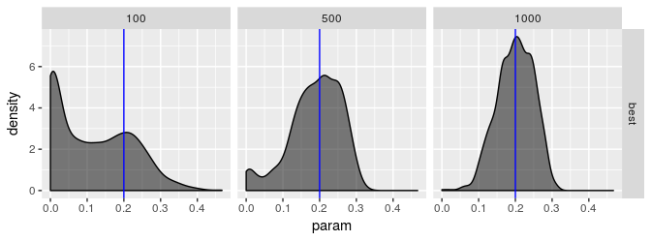
- \(\alpha\) 估计,model 1
solver_density_plot(
"alpha1", "best",
lapply(
list(spec1_n100, spec1_n500, spec1_n1000),
function(l)
{
optMethodSims_getBestVals(
l, reslike = TRUE)
}),
c(100, 500, 1000), spec1)
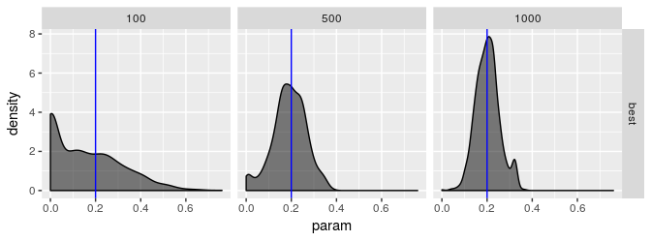
- \(\beta\) 估计,model 1
solver_density_plot(
"beta1", "best",
lapply(
list(spec1_n100, spec1_n500, spec1_n1000),
function(l)
{
optMethodSims_getBestVals(
l, reslike = TRUE)
}),
c(100, 500, 1000), spec1)
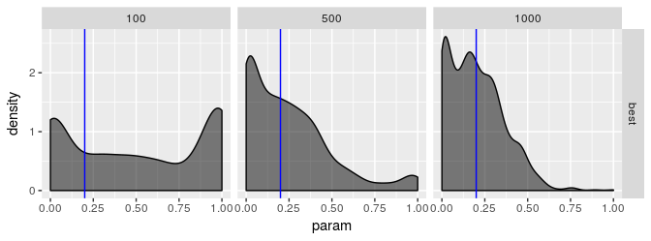
- \(\omega\) 估计,model 2
solver_density_plot(
"omega", "best",
lapply(
list(spec2_n100, spec2_n500, spec2_n1000),
function(l)
{
optMethodSims_getBestVals(
l, reslike = TRUE)
}),
c(100, 500, 1000), spec2)

- \(\alpha\) 估计,model 2
solver_density_plot(
"alpha1", "best",
lapply(
list(spec2_n100, spec2_n500, spec2_n1000),
function(l)
{
optMethodSims_getBestVals(
l, reslike = TRUE)
}),
c(100, 500, 1000), spec2)
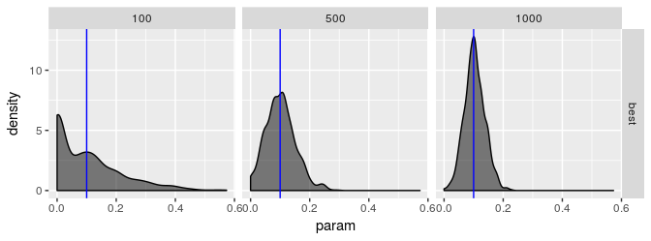
- \(\beta\) 估计,model 2
solver_density_plot(
"beta1", "best",
lapply(
list(spec2_n100, spec2_n500, spec2_n1000),
function(l)
{
optMethodSims_getBestVals(
l, reslike = TRUE)
}),
c(100, 500, 1000), spec2)
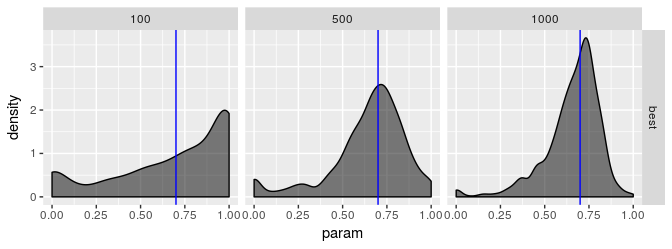
这些图表明,“最佳”估计器仍然显示出一些病态,即使它的表现不如其他估计器差。无论模型选择如何,我都没有看到参数估计有偏的证据,但我不相信“最佳”估计器真正最大化对数似然,特别是对于较小的样本量。\(\beta\) 的估计值特别糟糕。即使 \(\beta\) 的标准差应该很大,我也不认为它应该像图中揭示的那样向 0 或 1 倾斜。
结论
我最初在一年前写过这篇文章,直到现在才发表。中断的原因是因为我想得到一个关于估计 GARCH 模型参数替代方法的文献综述。不幸的是,我从未完成过这样的综述,而且我已经决定发布这篇文章。
那就是说,我会分享我正在读的东西。Gilles Zumbach 的一篇文章试图解释为什么估计 GARCH 参数很难。他指出,求解器试图最大化的准似然方程具有不良特性,例如非凸,且具有可能让算法陷入困境的“平坦”区域。他提出了另一种寻找 GARCH 模型参数的方法,在一个替代参数空间中找到最佳拟合(假设它具有比所使用 GARCH 模型的原始参数空间更好的属性),并且使用例如矩方法估计其中一个参数,而没有任何优化算法。另一篇由 Fiorentini、Calzolari 和 Panattoni 撰写的文章表明,GARCH 模型的解析梯度可以明确计算,因此这里看到的优化算法所使用的无梯度方法实际上并不是必需的。由于数值微分通常是一个难题,这可以帮助确保不会引入导致这些算法无法收敛的额外数值误差。我还想探索其他估计方法,看看它们是否能够以某种方式完全避免数值技术,或具有更好的数值属性,例如通过矩估计。我想阅读 Andersen、Chung 和 Sørensen 撰写的文章,以了解有关这种估计方法的更多信息。
然而,生活正在继续,我没有完成这篇综述。项目继续进行,基本上很好地避免了估计 GARCH 模型参数的问题。也就是说,我想重新审视这一点,或许可以探索模拟退火等技术如何用于估计 GARCH 模型参数。
所以现在,如果你是一名从业者,在估计 GARCH 模型时你应该怎么做?我想说不要理所当然地认为你的包使用的默认估计算法会起作用。你应该探索不同的算法和不同的参数选择,并使用导致最大对数似然的结果。我展示了如何以自动化方式完成这项工作,但你应该准备手动选择最佳的模型(由对数似然确定)。如果你不这样做,你估计的模型实际上可能不是理论可行的模型。
我将在本文的最后再次说一遍,特别强调:不要将数值技术和结果视为理所当然的!
sessionInfo()
## R version 3.4.2 (2017-09-28)
## Platform: i686-pc-linux-gnu (32-bit)
## Running under: Ubuntu 16.04.2 LTS
##
## Matrix products: default
## BLAS: /usr/lib/libblas/libblas.so.3.6.0
## LAPACK: /usr/lib/lapack/liblapack.so.3.6.0
##
## locale:
## [1] LC_CTYPE=en_US.UTF-8 LC_NUMERIC=C
## [3] LC_TIME=en_US.UTF-8 LC_COLLATE=en_US.UTF-8
## [5] LC_MONETARY=en_US.UTF-8 LC_MESSAGES=en_US.UTF-8
## [7] LC_PAPER=en_US.UTF-8 LC_NAME=C
## [9] LC_ADDRESS=C LC_TELEPHONE=C
## [11] LC_MEASUREMENT=en_US.UTF-8 LC_IDENTIFICATION=C
##
## attached base packages:
## [1] parallel stats graphics grDevices utils datasets methods
## [8] base
##
## other attached packages:
## [1] ggplot2_2.2.1 rugarch_1.3-8 printr_0.1
##
## loaded via a namespace (and not attached):
## [1] digest_0.6.16 htmltools_0.3.6
## [3] SkewHyperbolic_0.3-2 expm_0.999-2
## [5] scales_0.5.0 DistributionUtils_0.5-1
## [7] Rsolnp_1.16 rprojroot_1.2
## [9] grid_3.4.2 stringr_1.3.1
## [11] knitr_1.17 numDeriv_2016.8-1
## [13] GeneralizedHyperbolic_0.8-1 munsell_0.4.3
## [15] pillar_1.3.0 tibble_1.4.2
## [17] compiler_3.4.2 highr_0.6
## [19] lattice_0.20-35 labeling_0.3
## [21] Matrix_1.2-8 KernSmooth_2.23-15
## [23] plyr_1.8.4 xts_0.10-0
## [25] spd_2.0-1 zoo_1.8-0
## [27] stringi_1.2.4 magrittr_1.5
## [29] reshape2_1.4.2 rlang_0.2.2
## [31] rmarkdown_1.7 evaluate_0.10.1
## [33] gtable_0.2.0 colorspace_1.3-2
## [35] yaml_2.1.14 tools_3.4.2
## [37] mclust_5.4.1 mvtnorm_1.0-6
## [39] truncnorm_1.0-7 ks_1.11.3
## [41] nloptr_1.0.4 lazyeval_0.2.1
## [43] crayon_1.3.4 backports_1.1.1
## [45] Rcpp_1.0.0



 浙公网安备 33010602011771号
浙公网安备 33010602011771号